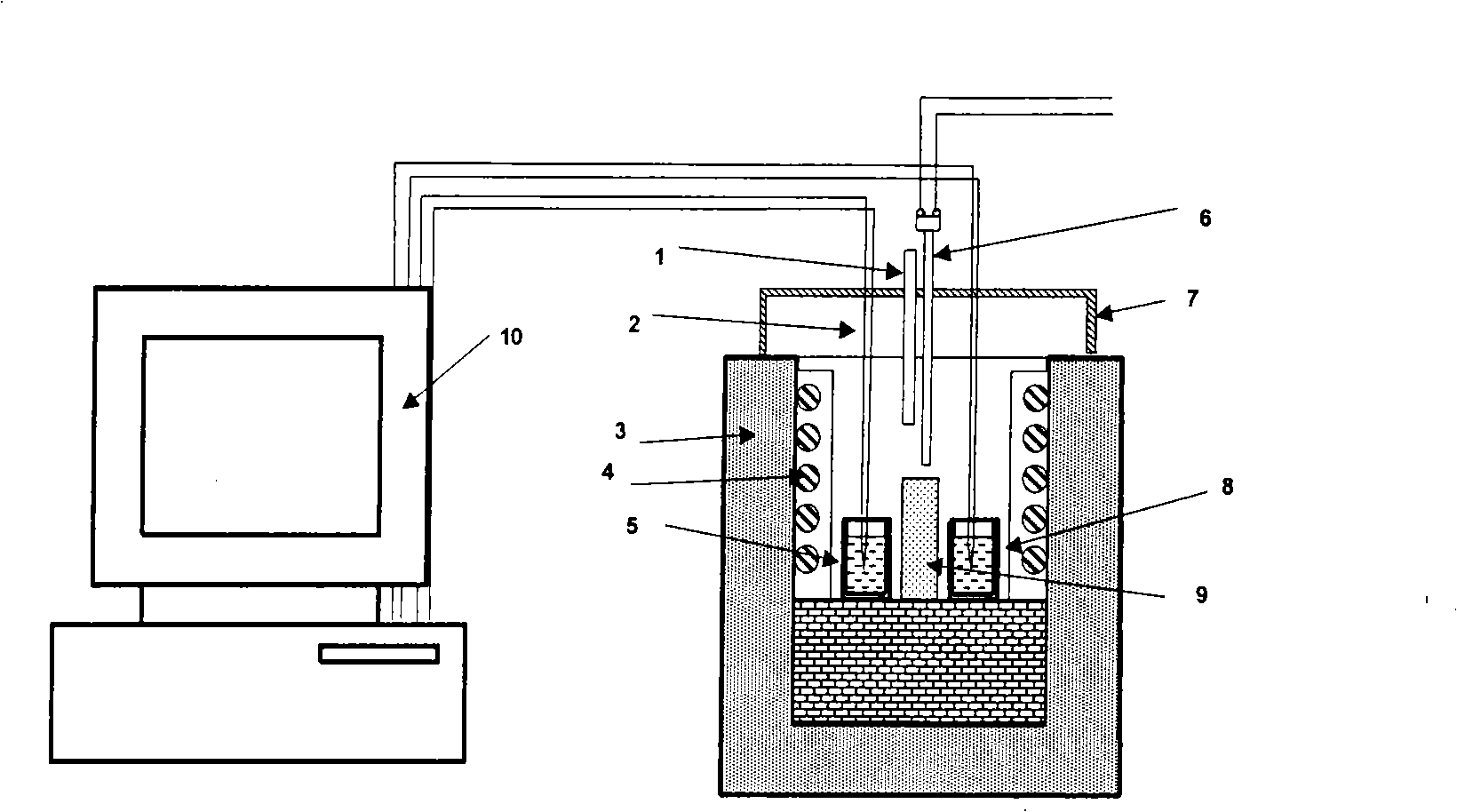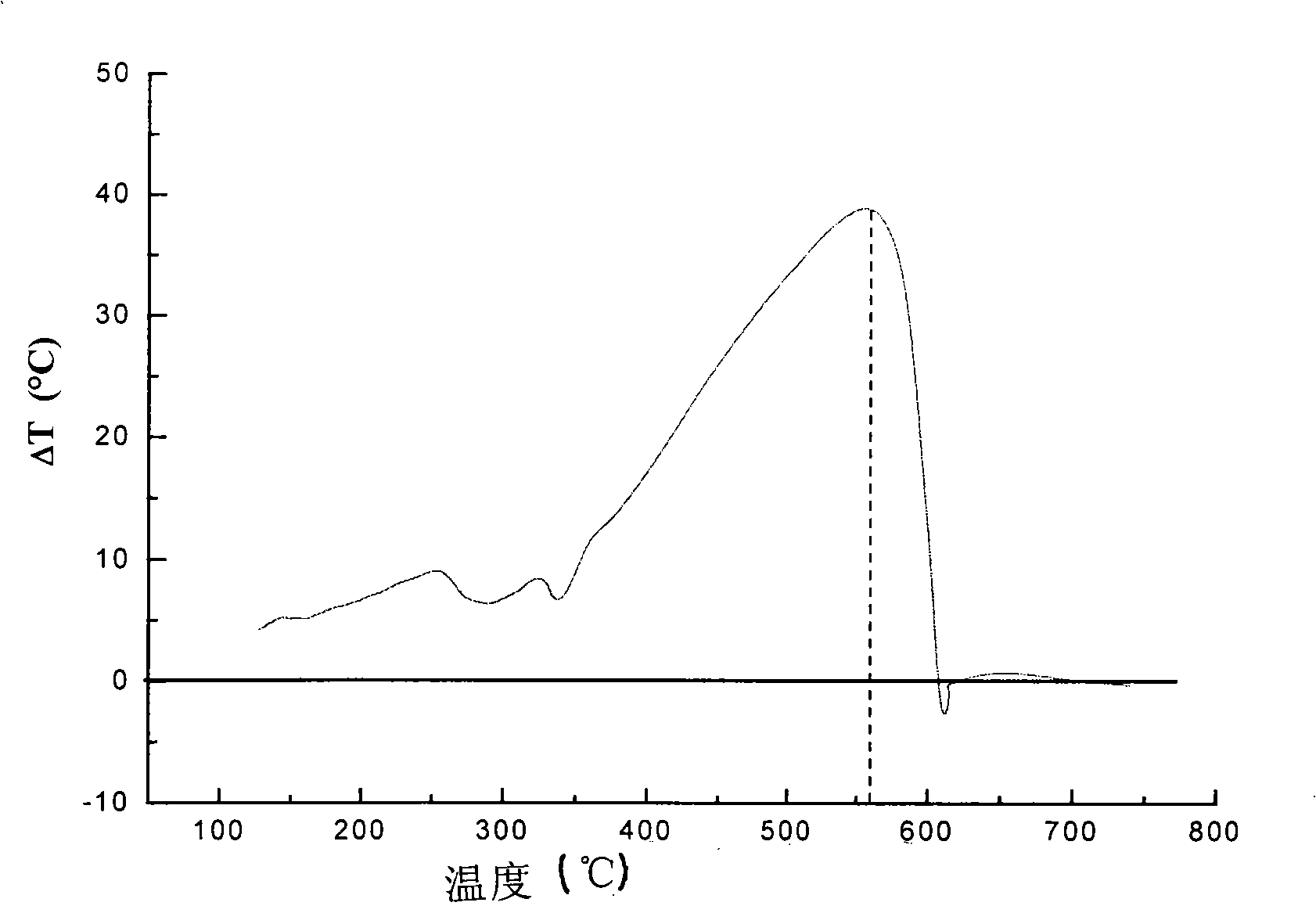Rare-earth magnesium alloy solidification process comparison heat analysis method
A rare earth magnesium and thermal analysis technology, applied in the field of material science, can solve the problems of affecting the measurement results, not being able to track the solidification process of the magnesium alloy throughout the process, and damaging the measuring instrument, etc., to achieve the effect of accurate measurement
- Summary
- Abstract
- Description
- Claims
- Application Information
AI Technical Summary
Problems solved by technology
Method used
Image
Examples
Embodiment 1
[0028] Such as figure 1 Shown is a schematic diagram of the thermal precipitation device for the determination of rare earth magnesium alloys of the present invention. Mixed gas (SF 6 +CO 2 ) The air intake pipe 1 stretches into the resistance furnace 3 through the furnace cover 7, and the volume flow ratio of the mixed gas is SF 6 :CO 2 =1:100, air pressure is 0.3Kg / cm 2 One end of the nickel-chromium-nickel-silicon thermocouple wire 2 is connected with the computer terminal 10, and the other end is stretched into the crucible 5 and 8, the both sides inner wall of the resistance furnace 3 is provided with a resistance wire 4, and the inside of the resistance furnace 3 is placed with a crucible 5 And 8, one end of the thermocouple 6 is connected to the power supply, and the other end is fixed above the central heat insulating layer 9 in the resistance furnace 3 through the furnace cover 7 .
[0029] Put ZA52Nd1 alloy and ZA52 alloy (each 200g, see attached table 1 for com...
Embodiment 2
[0033] Put ZA52Nd2 alloy and ZA52 alloy (200g each, see attached table 1 for composition), respectively into small iron crucibles 5 and 8 of the same size, and heat them in a resistance furnace until melting. The heating and cooling process is in (SF 6 +CO 2 ) under the protection of mixed gas, the volume flow ratio of the mixed gas is SF 6 :CO 2 =1.2:98, air pressure is 1.0Kg / cm 2 When the samples in the two crucibles are completely melted and converge to 720°C, the resistance furnace is powered off, the melts in crucibles 5 and 8 are cooled with the furnace, and the cooling temperature is recorded every 0.05 seconds. Subtract the temperature of the ZA52 sample from the solidification cooling temperature of the ZA52Nd2 sample at the same time, and draw a curve with the solidification cooling temperature as the horizontal axis and the temperature difference as the vertical axis. The peak of the curve appears in the temperature range of 551°C to 565°C. With the identificatio...
Embodiment 3
[0035] Put ZA52Nd4 alloy and ZA52 alloy (200g each, see attached table 1 for composition), respectively into small iron crucibles 5 and 8 of the same size, and heat them in a resistance furnace until melting. The heating and cooling process is in (SF 6 +CO 2 ) under the protection of mixed gas, the volume flow ratio of the mixed gas is SF 6 :CO2 =1.2:100, air pressure is 0.7Kg / cm 2 When the samples in the two crucibles are completely melted and converge to 720°C, the resistance furnace is powered off, the melts in crucibles 5 and 8 are cooled with the furnace, and the cooling temperature is recorded every 0.05 seconds. Subtract the temperature of the ZA52 sample from the solidification cooling temperature of the ZA52Nd4 sample at the same time, and draw a curve with the solidification cooling temperature as the horizontal axis and the temperature difference as the vertical axis. The peak of the curve appears in the temperature range of 554°C to 562°C. With the identification...
PUM
 Login to View More
Login to View More Abstract
Description
Claims
Application Information
 Login to View More
Login to View More - R&D
- Intellectual Property
- Life Sciences
- Materials
- Tech Scout
- Unparalleled Data Quality
- Higher Quality Content
- 60% Fewer Hallucinations
Browse by: Latest US Patents, China's latest patents, Technical Efficacy Thesaurus, Application Domain, Technology Topic, Popular Technical Reports.
© 2025 PatSnap. All rights reserved.Legal|Privacy policy|Modern Slavery Act Transparency Statement|Sitemap|About US| Contact US: help@patsnap.com


